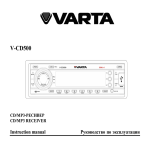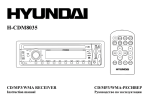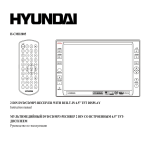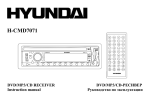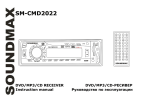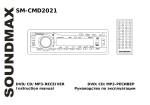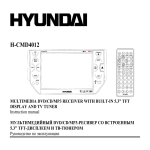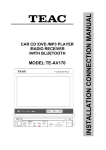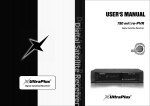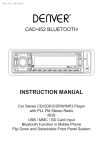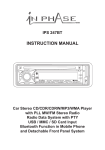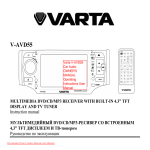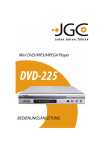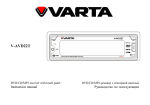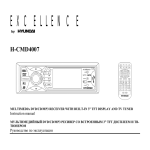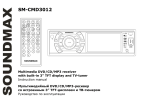Download Hyundai DVD/CD/MP3 User's Manual
Transcript
H-CMD7086 DVD/CD/MP3 RECEIVER WITH BLUETOOTH DVD/CD/MP3C BLUETOOTH Instruction manual Dear customer! Thank you for purchasing our product. For safety, it is strongly recommended to read this manual carefully before connecting, operating and/or adjusting the product and keep the manual for reference in the future. Table of contents Table of contents ...............................................................................................................................................2 Important safeguards .........................................................................................................................................3 Accessories........................................................................................................................................................4 Installation/connection.......................................................................................................................................5 Panel controls .................................................................................................................................................. 11 General operations...........................................................................................................................................15 Digital tuner operations ...................................................................................................................................18 Disc glossary ...................................................................................................................................................21 DVD/SD/MMC/USB operations......................................................................................................................22 MP3 overview .................................................................................................................................................29 DVD setup.......................................................................................................................................................31 Bluetooth operation (option) ............................................................................................................................34 Handling discs .................................................................................................................................................37 Cleaning ..........................................................................................................................................................37 Troubleshooting guide .....................................................................................................................................38 Specification....................................................................................................................................................40 2 Important safeguards Read carefully through this manual to familiarize yourself with this high-quality sound system. The beginning of operation is the moment of the unit installation. Before use the device in winter it is recommended to heat up the passenger compartment during 20 seconds or to the operation temperature. Use the unit with the temperature that goes beyond the operation temperature greatly decreases the operation resource of the screen and other components of device and can result an outage. Disconnect the vehicle's negative battery terminal while mounting and connecting the unit. When replacing the fuse, be sure to use one with an identical amperage rating. Using a fuse with a higher amperage rating may cause serious damage to the unit. Do not attempt to disassemble the unit. Laser beams from the optical pickup are dangerous to the eyes. Make sure that pins or other foreign objects do not get inside the unit; they may cause malfunctions, or create safety hazards such as electrical shock or laser beam exposure. Do not use the unit in places where it can be exposed to water, moisture and dust. Do not open covers and do not repair yourself. Consult the dealer or an experienced technician for help. Make sure you disconnect the power supply and aerial if you will not be using the system for a long period or during a thunderstorm. Make sure you disconnect the power supply if the system appears to be working incorrectly, is making an unusual sound, has a strange smell, has smoke emitting from it or liquids have got inside it. Have a qualified technician check the system. The unit is designed for negative terminal of the battery, which is connected to the vehicle metal. Please confirm it before installation. Do not allow the speaker wires to be shorted together when the unit is switched on. Otherwise it may overload or burn out the power amplifier. 3 Accessories Receiver Remote controller Panel protective case AV cable USB cable ISO cable Mounting parts: Release keys Screw 20 Bolt 6 Washer Nut Mounting strap Rubber Consumer information Warranty card Instruction manual 1 pc 1 pc 1 pc 1 pc 1 pc 1 pc 2 pc 1 pc 4 pc 2 pc 1 pc 1 pc 1 pc 1 pc 1 pc 1 pc 4 Installation/connection Choose the mounting location where the unit will not interfere with the normal driving function of the driver. Before finally installing the unit, connect the wiring and make sure that the unit works properly. Consult with your nearest dealer if installation requires the drilling of holes or other modifications of the vehicle. Install the unit where it does not get in the driver's way and cannot injure the passenger if there is a sudden stop, like an emergency stop. If installation angle exceeds 30° from horizontal, the unit may not perform properly. Avoid installing the unit where it would be subject to high temperature, such as from direct sunlight, or from hot air, from the heater, or where it would be subject to dust, dirt or excessive vibration. Din Front/Rear-Mount This unit can be properly installed either from 'Front' (conventional DIN Front-mount) or 'Rear' (DIN Rearmount installation, utilizing threaded screw Holes at the sides of the unit chassis). For details, refer to the following illustrated installation methods. DIN FRONT-MOUNT (Method A) 1. Car dashboard 2. Sleeve 3. Screw 4. Nut 5. Spring washer 6. Screw 7. Metal strap 8. Flat washer 5 1. Install the sleeve into the dashboard; ensure it is installed with the correct side and there are no obstacles (wires, dashboard elements, etc) for the unit installation. 2. After installing the sleeve into the dashboard, bend tabs fitting to the size of the dashboard to fix the sleeve in place. 3. Use the metal strap to fix the rear side of the unit. Determine a place for fixing and install the strap as shown in the picture. You can bend the strap to the needed angle with your hands. 4. Make the necessary wire connections. Ensure the connections are correct. 5. Install the unit into the sleeve until the side locks are fixed. Dismantling the unit – Trim frame – Frame uninstall direction – Release key insertion 1. Switch off the unit and detach the front panel. 2. Insert your fingers into the groove in the front side of the trim frame (apply some effort to detach the frame). Pull the frame to detach it. 3. Insert the supplied release keys into the both sides of the unit body to click, as shown in the picture. To extract the unit from the dashboard, pull the release keys or the unit body to pull it out. Before detaching the unit, ensure it is not fixed with the metal strap. 6 Trim frame installation To install the trim frame, press it to the unit body and push it to fix it in place. This should be done before installing the front panel; otherwise you are not able to install the trim frame. When the trim frame being installed, the side with the groove should face down and fixed first. 2. DIN REAR-MOUNT (Method B) For this method, use the screw holes in the lateral sides of the unit. Fix the unit with the help of the factory radio mounting brackets. 1. Select a position in which the screw holes of the brackets (3) are aligned with the screw holes in the unit body, and screw in two screws (2) in each side. 2. Screw. 3. Factory radio mounting brackets. 4. Vehicle dashboard. 5. Lock (remove this part). Note: The outer trim frame and mounting sleeve are not used for method of installation. Detaching the front panel 1. Press OPEN button on the front panel. The panel will go down (pic. 1). 2. Push the panel to the right and then pull it towards you (pic. 2). Pic. 1 Pic. 2 7 Attaching the control panel 1. Insert the right side of the control panel into the main unit (pic. 3). 2. Press the control panel on to the left side of middle of it until a “click” sound is heard (pic. 4). Pic. 4 Pic. 3 Caution: Do not insert the control panel from the left side. It can damage the control panel. The control panel can easily be damaged by shocks. After removing it, place it in a protective case and be careful not to drop it or subject it to strong shocks. The rear connector that connects the main unit and the control panel is an extremely important part. Be careful not to damage it by pressing on it with fingernails, pens, screwdrivers, etc. Note: If the control panel is dirty, wipe off the dirt with soft, dry cloth only. And use a cotton swab soaked in isopropyl alcohol to clean the socket on the back of the control panel. 8 Electrical connection Caution: For some car models you may need to modify wiring of the supplied power cord. Contact your authorized car dealer before installing this unit. Notes: 2 cable is connected to a Hands-Free device (not included). 9 The parking wire is connected with brake signal; for safety, the programs can be seen on the monitor after braking the car. 10 Panel controls Front panel 1. PWR/MUTE button 2. OPEN button 3. SD/MMC card slot 4. DISC slot 5. EJECT button 6. USB jack 7. AV IN 8. MODE/REJECT CALL button 9. ACCEPT CALL button 10. DIS/DUAL button 11. VOL KNOB/SEL button 12. TA/DSP button 13. PTY/SCAN button 14. AF/MONO button 15. BAND/LOUD button 16. NEXT button 17. PREVIOUS button 18. AS/PS button 19. 1/PLAY/PAUSE button 20. 2/REPEAT button 21. 3/INTRO button 22. 4/RANDOM button 11 23. 5/ DIR- button 24. 6/DIR+ button 25. IR remote control sensor 26. Microphone 27. Panel status indicator 28. RESET button Inner panel 12 Remote control 1. 2. 3. 4. 5. 6. 7. 8. 9. 10. 11. 12. 13. 14. 15. 16. 17. 18. 19. 20. 21. 22. 23. 24. DISP/DUAL button STANDBY button OSD button ST/MO button SETUP button ENTER button PREVIOUS/NEXT button ANGLE button VOL- button SEL button BAND/RDM button AUDIO/GOTO button Number buttons ACCEPT CALL/T-MENU button TITLE button DSP button MODE button MUTE button MENU button Cursor buttons (LEFT, RIGHT, UP, DOWN) PLAY/PAUSE button INT button 25. A-B/ZOOM button VOL+ button 26. SUB-T button STOP/PBC button 27. PROG/PTY button 13 28. P.SCN/RPT button 29. REJECT CALL button Changing the battery 1. Pull out the battery tray. Insert the 1 x lithium battery, type CR 2025 3V battery with the stamped (+) mark facing upward. 2. Insert the battery tray into the remote control. Warning: Store the battery where children cannot reach. If a child accidentally swallows the battery, consult a doctor immediately. Do not recharge, short, disassemble or heat the battery or dispose it in a fire. Do not expose or bring into contact the battery with other metallic materials. Doing this may cause the battery to give off heat, crack or start a fire. When throwing away or saving the battery, wrap it in tape and insulate; otherwise, the battery may give off heat, crack or start a fire. 14 General operations Reset the unit Operating the unit for the first time or after replacing the car battery, you must reset the unit. Press OPEN button on the panel to open the panel and press RESET button to restore the unit to the original factory settings. Power button Press any button on the panel (except OPEN button) or STANDBY button on the RC to turn on the unit. Press and hold PWR/MUTE button on the panel or STANDBY button on the RC to switch the unit off. Note: After the unit is off, the volume level and radio current settings will be memorized, and when you turn the unit on it will resume the stored status you set. Volume control Rotate VOL knob on the panel or press VOL +/- on the RC to adjust the volume level. Setting the sound characteristics Press shortly and repeatedly the SEL button to select the audio setting: VOLUME (VOL) => BASS => TREBLE (TRB) => BALANCE (BAL) => FADER (FAD). Rotate VOL knob or press VOL+/- buttons on the RC to regulate each setting. Note: If turning off the power all the settings of each mode will be saved. If turning off the ACC power or reset the unit all the settings will become as they were set on the plant. If you don’t adjust VOL knob within 6 seconds after selecting the desired setting, the unit will automatically return to the current mode being displayed. 15 Setting other characteristics During TUNER mode press SEL button and hold for 2 seconds, shortly and repeatedly press SEL button to select the setting: TA SEEK => PI MUTE => RETUNE L => MASK DPI =>TA VOL => EON TA => DISP REV => BEEP. To adjust the selected setting, rotate VOL knob or press VOL+/- buttons on the RC. TA SEEK/TA ALARM In TA SEEK mode, the unit will seek for traffic announcement program when TA is pressed; in TA ALARM mode, no TA/TP is displayed and the alarm is set off. After choosing, please leave the unit idle to activate. PI SOUND/MUTE PI SOUND refers to the reception noise when the AF function tries to scan alternative frequency. RETUNE S/L - SHORT/LONG RETUNE refers to the time period the unit allows for radio scan when reception is interrupted. “S” represents a time period of 30 seconds and “L” represents a time period of 90 seconds. MASK DPI/MASK ALL During MASK DPI mode, the unit will mask only the AF which has different PI, this is the default mode; during MASK ALL mode, the unit will mask the AF which has different PI and no RDS signal with high field strength. TA VOLUME: Rotate the knob or press VOL+/- button to choose the volume level of TA announcements. EON TA: Rotate the knob to select EON TA LO/EON TA DX mode. If you want to receive information from local stations only, select EON LO mode. Otherwise, select EON TA DX mode. BEEP Turn BEEP on if you want the pressing of buttons to be sounded. Press SEL Button until the display shows BEEP, then use the VOL+/- Button to turn BEEP sound ALL or OFF or 2ND (you hear BEEP sound when you press and hold a button). DISP REV: Rotate the knob to select LED display color between black and white. 16 Turning the sound off Press MUTE button on the RC or PWR/MUTE button on the unit to turn the sound off. Press it again or press VOL+/- buttons on the RC or rotate VOL knob on the panel to turn the sound on. Mode setting Press MODE/REJECT CALL button on the panel or MODE button on the RC repeatedly to select: TUNER => DVD (if inserted) => USB (if USB device is inserted) => SD (if the flash card is inserted) => AUX. Equalizer setting Press and hold TA/DSP button on the unit or press DSP button on the RC to select the equalizer mode: FLAT => CLASSICS => POP => ROCK => DSP OFF. AV jack Intended to receive audio and video signals by connecting to outside input device. Display Press DIS/DUAL button on the unit or DISP/DUAL button on the RC to see current tuning information and time. Sequence of the menu: Clock/Time => Radio Frequency => PTY=> Exit. 17 Digital tuner operations Note: RDS (Radio Data System) service availability varies with areas. Please understand if RDS service is not available in you area, the following service is not available, either. RDS overview PI: Program Identification Code – for identifying code. PS: Program Service Name Broadcast – station name data expressed in alphanumerically character. TP: Traffic Program Identification – for traffic information broadcasting station. TA: Traffic Announcement Identification – showing traffic information is being transmitted or not. AF: Alternative frequencies – frequency list of broadcasting station transmitting the same program. Band selection In Tuner mode press BAND once or more to select: FM1, FM2, FM3, MW1 (AM1), MW2 (AM2). Manual/automatic tuning Manual tuning: select a band. Press and hold PREVIOUS/NEXT buttons, MANUAL appears on the display, then press these buttons repeatedly to search a station step by step upward or downward. Automatic tuning: select a band. Press PREVIOUS/NEXT buttons, the automatic backward/forward search will start. It will play when finds the station. Programming tuner stations You can store up to a total of 30 radio stations in the memory (18 FM, 12 AM (MW)). To store a station: - Select a band; - Select a station by pressing PREVIOUS/NEXT buttons. 18 - Hold a preset button (1-6), which you want store the station for at least 2 seconds. To recall a station: - Select a band (if needed) - Press a preset button (1-6) briefly to recall the stored station. AF/MONO button Press AF/MONO button to enable AF mode. Press and hold AF/MONO on the unit or press ST/MO on the RC to choose MONO or STEREO. Auto memory store Select a band. Press AS/PS button on the panel or P.SCN/RPT button on the RC and hold for 2 seconds to enter auto store mode. The radio will automatically store 6 stations to the 6 preset memories of the current band. To stop auto store, press this button again. Preset scan Select a band. Press AS/PS button on the panel or P.SCN/RPT button on the RC to scan all preset stations in the memories of the current band. To stop preset scan, press the button again. TA (Traffic Announcement) function 1. Press TA/DSP button shortly to turn on or turn off the TA function. When the TA function, TA icon will be displayed. 2. When TA or TP RDS signal is available from the current station, TP icon is turned on. When TA/TP is enabled (on), but no traffic announcement is transmitted, TP icon is off and TA icon keeps blinking. AF (Alternative Frequencies) function Press AF/MONO button on the panel shortly to turn on or turn off the AF function. If the AF function is on the display will show “AF”. When AF switching mode is selected, but RDS information is not received yet the “AF” will be flashing. 19 The RDS program will be automatically searched and received. After turning on, if the RDS signal is weak or even no signal, the unit will search another frequency with this RDS program. Default setting is ON. PTY (Program Type) function 1. Press PTY/SCN button on the panel or press PROG/PTY button on the RC to select the program type group: MUSIC GROUP => twice to select SPEECH GROUP => PTY OFF. 2. When the program type is selected press digit buttons (1~6) repeatedly to select the program type according to the table: Preset number 1 2 3 4 5 6 3. 4. PTY music group POP M, ROCK M EAST M, LIGHT M CLASSICS, OTHER M JAZZ M, COUNTRY M NATION M, OLDIES M FOLK M Preset number 1 2 3 4 5 6 PTY speech group NEWS, AFFAIRS, INFO SPORT, EDUCATE, DRAMA CULTURE, SCIENCE, VARIED WEATHER, FINANCE, CHILDREN SOCIAL, RELIGION, PHONE IN TRAVEL, LEISURE, DOCUMENT Searching will start. If PTY code is different or not available, the PTY icon will start blinking. Press PTY/SCN button on the panel or PROG/PTY button on the RC to switch the PTY function off. 20 Disc glossary PBC (PlayBack Control) PBC is a menu recorded on the disc with SVCD or VCD2.0 format. For the discs contained PBC, it can playback interactive software with the menu displayed on TV. And if the disc contains still images, it can playback high definition of still image. Title The title is the important part of DVD disc. The memory volume of the disc is rather big, that makes possible to record several films on one disc. For example, if a disc contains three films, they may be divided into Title 1, Title 2 and Title 3. You can easy use the functions of looking-for. Chapter A title can be divided into several blocks, so that every block can be operated as a unit, the unit is called chapter. The chapter contains a unit at least. Track It is the biggest component of VCD. Generally, every song of karaoke disc is a track. 21 DVD/SD/MMC/USB operations Discs for playback This unit can play disc types: DVD/DVD±R/±RW/CD/CD-R/CD-RW. Compatible with formats: DVD/SVCD/VCD/DVD Audio/CDDA/MP3/CD/WMA/ HDCD/Picture-CD/ Photo-CD/JPEG. The following file types are supported: Audio files: MP3 (*.mp3) WMA (*.wma) Video files: MP4 (*.avi, DIVX3.11/4.0/5.0/6.0 and XVID) MPEG 2(*.vob) MPEG 1(*.dat) Picture file: JPEG (*.jpg) ISO 9660 or ISO 9660 +Joliet format - Max. 30 characters Max. Track number is 448 Max. nested directory is 8 levels The max. album number is 99 The max. length of each track is 99 minutes 59 seconds Supported sampling frequency for MP3 disc: 8 KHz – 48 KHz (44.1 KHz preferably) Supported bit-rates of MP3 disc are: 32 - 320 kbps (128 kbps preferably). Following formats are NOT supported *.ACC, *.DLF, *.M3U, *.PLS, MP3 PRO, files with DRM. Open session discs are NOT supported. 22 USB/SD/MMC notes USB functions (flash memory type) MP3 music play. 1. SD/MMC card support, 2in1 (SD/MMC) support. 2. USB flash memory. 3. FAT 12/ FAT 16/ FAT 32 is possible - FAT 12/16 (dir: 200 support, file: 500 support), - FAT 32 (dir: 200 support, file: 500 support). 4. Filename: 32 byte/ Dir name: 32 byte. 5. Tag (id3tag ver2.0) - Title/ Artist/ Album: 32 byte support. 6. Multi card reader not supported. 7. USB 2.0 support. Notes: USB format supports 2.0. Capacity: up to 2 GB. SD cards brands: Cannon, Fuji film, Palm, Motorola, Microsoft, IBM, HP, Compaq, Sharp, Samsung, etc. Capacity: up to 2 GB. MMC cards brands: Ericsson, Nokia, Motorola, HP, Palm, Sanyo, Microsystems, etc. Capacity: up to 2 GB. 23 Loading/Ejecting a disc Turn the power on. Press OPEN button on the panel. Insert the disc with the printed side facing upward into the slot. Press EJECT button on the inner side to eject the disc. Inserting the SD/MMC card/USB device Insert the MMC/SD card or USB device into MMC/SD compartment or USB socket. Then the playing mode will be changed into MMC/SD or USB mode automatically. The first card/USB device track playback will start. Note: When MMC/SD card and USB device are both inserted into their compartment or socket, the playing mode will be changed into the mode of the later one. Playing/pausing When the disc/card/USB device has been already loaded the playback of the first track starts automatically. To ensure good system performance, wait until the unit finishes reading the disc information before proceeding. Or press PLAY/PAUSE button to start playback. Press it again to pause the playback. Press again to resume the playback. Playing the previous/next track During playback press PREVIOUS button to play the previous track. Press NEXT button to play the next track. Fast forward and fast backward Repeatedly press and hold PREVIOUS/NEXT buttons to select the speed of fast backward/forward playing. The playback speed will change after each pressing. Note: During the disc playback when fast backward/forward playback gets to the beginning of the playing another track, it resumes normal playback. 24 DIR+/DIRPress 5/DIR-, 6/DIR+ buttons to choose folder. Loudness Press and hold BAND/LOUD button on the panel or DSP button on the RC to turn loudness on or off. Repeat playback Press RPT button on the panel or P.SCN/RPT button on the RC to start repeat playing. Press one more time to cancel. The repeating sequence: In MP3 mode: FILE => FOLDER => ALL. In DVD mode: Repeat OFF => Repeat TITLE => Repeat Chapter. In CD mode: Disc => Track. Note: to choose FOLDER repeating and TITLE repeating press and hold RPT button on the panel or P.SCN/RPT button on the RC. Changing angle (for DVD only) If DVD disc supports multi-angle playback, press ANGLE button on the RC to playback images in different camera angles. If discs doesn't support multi-angle playback, this function will not work. Selecting audio languages During DVD disc playback press AUDIO/GOTO button on RC repeatedly to select the audio language to listen (if the disc supports multi-language mode). Selecting the channel (for VCD only) During VCD disc playback press AUDIO button on the RC to select the channel: L-mono => R-mono =>Mix mono => Stereo. 25 Selecting subtitle language (for DVD only) Subtitle language is in disc initiation setting during playback. Press SUB-T button on the RC repeatedly to switch among disc-supported languages. Changing size (for DVD/VCD) During playback press and hold A-B/ZOOM button on the RC. The picture will be enlarged accordingly: X2=> X3=> X4=> X1/2=> X1/3=> X1/4=>Normal. A-B segment repeating Press A-B/ZOOM button to set A position, press one more time to set B position and start A-B repeating. Press this button one more time to cancel the repeating function. OSD (OnScreen Display) function Press OSD button on the RC repeatedly to show the disc information, such as: the Number of track, Current track time elapsed => Current track time remain => Total tracks time elapsed => Total tracks time remain, Language. Menu navigation (for DVD only) Title playing: - Press TITLE button on the RC to activate the disc title list on the screen. - Choose the desired title. - Press ENTER button or PLAY/PAUSE button to confirm the selected item and start playing. PBC (Playback Control) function (for VCD only) If you insert a VCD with PBC, playback starts from the beginning of the 1st track automatically. 1. Press and hold STOP/PBC button on the RC to set PBC on/off; when PBC on, the screen will show PBC menu. 26 2. If the menu consists of a list of titles, you can select a desired one using cursor buttons or number buttons on the RC while PBC is off. 3. The VCD starts playing the selected title automatically, or you can press PLAY/PAUSE button to confirm the selected track for playback. 4. Press STOP/PBC button to “STOP”, and press PLAY/ PAUSE button to continue playing. 5. Press STOP/PBC button to “STOP”, press again to “R.STOP”, and press PLAY/ PAUSE button to playback. Program playing During playback press PROG/PTY button on the RC to open the program menu. Press number buttons to select the track number and then press cursor buttons to move the cursor to PLAY. Press ENTER to start program playing. You can choose CLEAR ALL, to cancel the settings. Press PROG/PTY button to exit the program function. GOTO Press and hold AUDIO/GOTO button in DVD mode to enter GOTO mode and set chapter/track/time directly. Press ENTER button to start playback by the input parameters. MENU Press MENU button in DVD mode to show disc menu. Intro Press INT button to activate INTRO function, i.e. playing the beginning of every track for 10 seconds. Dual mode When playing DVD press and hold DIS/DUAL button on the panel or DUAL button on the RC to activate dual zone mode. Press MODE button on the RC or MODE/REJECT CALL button on the panel to choose tuner 27 mode for front zone, and at the same time DVD mode will be playing at the rear zone (in case of correct connection). Random In disc mode press and hold BAND/RDM button on the RC or RDM button on the unit to activate random playing mode. Press one more time to return to normal playing. 28 MP3 overview Notes on MP3: MP3 is short for MPEG Audio Layer 3 and refers to an audio compression technology standard. This product allows playback of MP3 files on CD-ROM, CD-R or CD-RW discs. The unit can read MP3 files written in the format compliant with ISO 9660. However it does not support the MP3 data written by the method of packet write. The unit can not read an MP3 file that has a file extension other than “.mp3”. If you play a non- MP3 file that has the “.mp3” extension, you may hear some noise. In this manual, we refer to what are called “MP3 file” and “folder” in PC terminology as “track” and “album”, respectively. Maximum number of directory level is 8, including the root directory. Maximum number of files and folders per disc is 256. The unit may not play tracks in the order of Track numbers. The unit plays only the audio tracks if a disc contains both audio tracks and MP3 files. When playing a disc of 8 kbps or “VBR”, the elapsed playing time in the display window will not be correct and also the intro play may not function properly. “VBR”: Variable Bit Rate. The unit supports the playback of WMA files. The playback of ID3 tags for WMA format is not guaranteed, it depends on versions and availability of Cyrillic alphabet. WMA (Windows Media Audio) – music data compression format, created by Microsoft Corporation. This format uses coding algorithm for compression of initial audio-record, greatly decreasing the file size, but, saving the good sound quality even when the bit rate is low (for example, 64 Kbit/s). 29 Notes on creating your own CD-R or CD-RW containing MP3 files: To enjoy high quality sound, we recommend converting to MP3 files with a sampling frequency of 44.1 kHz and a fixed bit rate o f 128 kbps. DO NOT store more than 256 MP3 files per disc. For ISO 9660 - compliant format, the maximum allowable depth of nested folders is 8, including the root directory (folder). When CD-R disc is used, playback is possible only for discs, which have been finalized. Make sure that when MP3 CD-R or CD-RW is burned that it is formatted as a data disc and NOT as an audio disc. You should not write non-MP3 files or unneeded folders along with MP3 files on the disc otherwise it takes a long time until the unit starts to play MP3 files. With some CD-R or CD-RW media, data may not be properly written depending on its manufacturing quality. In this case, data may not be reproduced correctly. High quality CD-R or CD-RW disc is recommended. Up to 16 characters are displayed for the name of an Album or a Track. ID3TAG version 1.x is required. Note that the unit may not play Tracks in the order that you wrote them to the disc. 30 DVD setup Press SETUP button to enter the OSD setting menu; press LEFT/RIGHT cursor buttons to move to the highlighted menu item and select one of the setup pages: Language, Display, Audio, Parental. Press UP/DOWN cursor buttons to select an item in the selected setup page. Press RIGHT button to move to the option list of the selected item. Select an option and press ENTER button to activate it. Language Language OSD language With this option you can select the language for your On Screen Display OSD lang Subtitle (OSD). This menu item has 6 languages available. Audio Subtitle With this option you can select the preferred language for the subtitles. Disc When the selected language is recorded on the disc, this language will Version automatically be shown. If not, the first language recorded on the disc is displayed. Audio With this option you can select the preferred language for the audio output. When the selected language is recorded on the disc (not all discs have multiple languages recorded) then this language will automatically be played. If not, the first language recorded on the disc is played. Disc With this option you can select the preferred language for the disc menu. When the selected language is recorded on the disc then this language will automatically be selected. If not, the first language recorded on the disc is displayed. Version With this option you can know the version of the unit. 31 Display setup TV display Display Three screen ratio modes are available, Normal/PS (4:3 Pan Scan), TV display Normal/LB (4:3 Letterbox) and Wide (16:9). Different disc formats will TV type display different images depending this setting and the screen size used. Angle mark TV type Screen saver Select this menu item to set up your preferred video output format. PAL is commonly used in Europe. NTSC is commonly used in the USA and Japan. Auto is commonly used automatically. Angle mark When playing a DVD disc and you have selected ON, then the screen will show the angle mark. This will give you the possibility to view multi angle DVD’s. Screen saver When playing a DVD disc and you have selected ON, the screen will enter Screen Saver mode if you stop playback for more than 3 minutes. Audio Downmix Audio If you want analog stereo signals, set the sound mode to Stereo. If you Downmix want to have Dolby Pro Logic stereo (the decoded signal will create a 2ch Dual mono reality simulating effect), select LT/RT. Dynamic Dual mono Select the type of output of the left and right audio output connectors. Stereo is normal Stereo, L-Mono is all sound on the Left Audio output, R-Mono is all sound on the Right channel. The Mix-Mono function only works when a DVD is being played in DTS 5.1 mode. 32 Dynamic setup This function is to adjust the linear compression rate to obtain the different compression results of the signals. Standard set to OFF. Parental Change With this option you can change your password. The default password is 0000 Parent For DVD discs that support this function, parents can prohibit watching content that might be inadvisable for children (use LEFT/RIGHT cursor buttons to choose rating code, then enter password to confirm). Default With this option you can clear all your setup and resume default setup. 33 Parental Change Parent Default Bluetooth operation (option) Feature: 1. Bluetooth specification V2.0 EDR compliant 2. Support HFP, A2DP, AVRCP. 3. Excellent ECHO cancellation with noise elimination 4. Dial 5. Display incoming and outgoing number 6. Call list 7. Phone book Pairing Before operation it needs to pair the mobile phone and receiver. Prepare your mobile phone for bluetooth connection. According to mobile manual pairing device, when searching new device (KBT), select it, put in pass code "8888" and confirm ok, device paring finished. Operate mobile connect to Bluetooth, after connecting Bluetooth, Bluetooth indicating LED will be on. Note: Make sure to keep the other Bluetooth device within 2 meters from this unit when making the pairing. Basic Telephone Operation Answer a call: Short press ACCEPT CALL button” ” to answer a call. Reject a call: Short press REJECT CALL button ” ” to reject a call. Hang up: Short press REJECT CALL button ” ” to hang up during dialing or talking. Dial Short press ACCEPT CALL button ” ”, LCD will blink with “_”, press digit buttons to input phone number, (Press SEL button on panel or LEFT cursor button on the RC to delete a wrong number), then press Accept Call button ” ” to dial the number. 34 Call list/number redial Short press ACCEPT CALL button once, the LCD screen will blink with “_” first, press it again to display the last number, then press NEXT/PREV button to display all incoming and outgoing numbers one by one. Press SEL button on panel or LEFT cursor button on the RC to delete a wrong number (max. 12). Note: While scrolling the numbers you can press ACCEPT CALL” ” button to redial any from the list. The functionality may be limited due to some phones' own dedicated interfacing specification. A2DP (Advance Audio Distribution Profile) A2DP is a function which can receive the audio frequency signal from mobile phone, amplify by car audio and play out by speaker. Operation: Enter Bluetooth music playing program via connect mobile phone (no need to connect if the unit already connected with phone) via play music. Note: A2DP need mobile phone support. AVRCP When the music is playing, Press PLAY/PAUSE button once to pause, press again to play. Press NEXT button to the next song, press PREVIOUS button to the previous song. Press VOL+/- buttons to adjust volume. Auto-connect When power on, the last paired phone will be connected to the device via Bluetooth automatically, after searching about one minute, if the device can not find the paired phone, it will stop searching. When in standby mode (unconnected), short press ACCEPT CALL” ” button to active auto-connect function and the device will search the last paired phone. 35 Phone book (Max store 250 numbers) Press ACCEPT CALL button “ ” once, the LCD screen will blink with “_” first, press digit 1 to show the English letter A, press PREV/NEXT button to display all the letters A-Z (represent the first letter of the call card name) and “*” (represent the first letter other than A-Z) one by one, then press ACCEPT CALL button “ ” to confirm, LCD will show the name with this letter as the first letter if existed (if the name with this first letter not existed, the LCD will display the next name according the order from A-Z), press ACCEPT CALL button “ ” once again to display the number, and then press it again to dial the number. (Press REJECT CALL button “ ” to return to the last step). Input Calling Card: Press ACCEPT CALL button “ ” to make the LCD screen blink with “_”, then press one by one #->1->2->3>4->#, after about 6 seconds, the LCD will show “Input”, (if you want to exit from inputting calling card, press ACCEPT CALL button” ” to show “Writing” and return), then operate your mobile phone to transmit calling cards one by one to the unit, the LCD will show the name of this call card, press ACCEPT CALL button “ ” to show “writing” on LCD, then the unit will store the call card. Clear up Calling Card: Press ACCEPT CALL button ” ” to make the LCD screen blink with “_”, then press one by one #->0->0->0>0-># to clear up all the stored calling cards. 36 Handling discs Dirty, scratched or warped discs may cause skip ping or noise. Handle the disc only by the edges. To keep clean do not touch its surface. Discs should be stored in their cases after use to avoid scratches. Do not expose discs to direct sunlight, high humidity, high temperature or dust. Prolonged exposure to extreme temperature can wrap the disc (such as leaving the discs in your car during summertime). Do not stick or write anything on either side of disc. Sharp writing instruments, or the inks used in some felt-tip pens, may damage its surface. Do not touch the unlabeled side. Do not attach any seal, label or data protection sheet to either side of a disc. Cleaning Cleaning the cabinet Wipe with a soft cloth. If the cabinet is very dampen (not dropping wet) the cloth with a weak solution of soapy water, and then wipe clean. Cleaning discs Fingerprints should be carefully wiped from the surface of disc with a soft cloth. Unlike conventional records, compact discs have no grooves to collect dust and macroscopic dirt, so gently wiping them with a soft cloth should remove must panicles. Wipe in a straight motion from the center to the edge. Never use thinner benzine, record cleaner or anti static spray on a compact disc. Such chemicals can damage its plastic surface. 37 Troubleshooting guide Symptom No power Cause The car ignition is not on. Disc cannot be loaded. The fuse is blown. Presence of disc inside the player. Disc cannot be read. (LCD shows “ERROR2”) SD/MMC cannot be read. (LCD shows “ERROR8”) USB cannot be read. (LCD shows “S-STOP”) No sound The buttons do not work. Sound skips. Inserting the disc in upside down. Compact disc is extremely dirty or defective. Temperature inside the car is too high. Metal interface is rusty, extremely dirty or defective. Metal interface is rusty, extremely dirty or defective. Volume is in minimum. Wiring is not properly connected. The built-in microcomputer is not operating properly due to noise. Front panel is not properly fix into its place. The installation angle is more than 30 degrees. The disc is extremely dirty or defective. 38 Solution If the power supply is properly connected to the car accessory switch the ignition key to “ACC”. Replace the fuse. Remove the disc in the player then put a new upward. Insert the compact disc with the label facing upward. Clean the disc or try to play a new one. Cool off until the ambient temperature returns to normal. Clean the metal interface or try to play a new one. Clean the metal interface or try to play a new one. Adjust volume to a desired level. Check wiring connection. Press RESET button. Reinstall the front panel. Adjust the installation angle to less than 30 degrees. Clean the compact disc/try to play a new one. The radio does not work, the radio station automatic selection does not work. The antenna cable is not connected the signals are too weak. 39 Insert the antenna cable firmly select a station manually. Specification General Power supply: Storage support: Compatible with: Current consumption: Maximum power output: Dimensions (L x W x H): Working temperature range: 12 V DC DVD/DVD±R/DVD±RW/CD/CD-R/CD-RW/USB/SD/MMC DVD/VCD/MPEG4/CDDA/MP3/WMA/HDCD/PictureCD/Photo CD/JPEG playback max. 15 A 50 W x 4 channels 178 x 175 x 50 mm -10º - +60º FM Stereo Radio Frequency range: Usable sensitivity: Preset memory stations: 87.5 - 108.0 MHz 15 uV 18 MW (AM) section Frequency range: Preset memory stations: Frequency response: S/N ratio (A-vtd): DSP sound effect: 522 kHz - 1620 kHz 12 20 Hz - 20 KHz 60 dB Classic, Rock, Pop, Flat Line out Output: Bluetooth 4 channel RCA line out (2V) Ver.2 Specifications are subject to change without notice. Dimension are approximate. 40 ! . , , . ....................................................................................................................................................41 ...............................................................................................................................42 ........................................................................................................................................43 ................................................................................................................................44 ...................................................................................................................................51 .......................................................................................................................................55 ...................................................................................................................59 .........................................................................................................................63 DVD/SD/MMC/USB ........................................................................64 3 WMA........................................................................................................................................71 DVD.............................................................................................................................................73 Bluetooth ( ) .......................................................................................................................76 ....................................................................................................................................80 .................................................................................................................................................80 ...............................................................................................81 ........................................................................................................................83 41 , . . 20 . , , . . , , . , . . , , . , , , . . , . . , , . , , , , , . . , . . , . , . 42 1 1 1 1 1 1 AV USB ISO : 20 6 2 1 4 2 1 1 1 1 1 1 43 , , . , . . , . , , , . 30°, . , , , , , , , , . . « « ), « » « » » ( » ( DIN DIN, , . 44 ). « 1. 2. 3. 4. 5. 6. 7. 8. »( ) . . 1. , , , ) . 2. , . . 3. . . . 4. 5. . . . 45 – – – 1. 2. . ). , . 3. , , . , ( , ). , . , ( .). « . . 46 »( ) 1. , (3) (2) 2. 3. 4. 5. . . . . ( ). : . 1. 2. OPEN . ( ( . 2). .2 .1 1. , , ( 2. . 1). .3). , ( . 4). .3 47 .4 : . : . , . . . , , . : , , 48 . . : . . : 2 Hands-Free ( 49 ). ; ( . 50 ) , 1. 2. 3. 4. 5. 6. 7. 8. 9. 10. 11. 12. 13. 14. 15. 16. 17. 18. 19. 20. 21. 22. PWR/MUTE OPEN SD/MMC EJECT USB AV MODE/REJECT CALL ACCEPT CALL DIS/DUAL VOL/ SEL TA/DSP PTY/SCAN AF/MONO BAND/LOUD NEXT PREVIOUS AS/PS 1/PLAY/PAUSE 2/RPT 3/INT 4/RDM 51 23. 24. 25. 26. 27. 28. 5/DIR6/DIR+ RESET 52 ( 1. 2. 3. 4. 5. 6. 7. 8. 9. 10. 11. 12. 13. 14. 15. 16. 17. 18. 19. 20. 21. 22. 23. 24. ) DISP/DUAL STANDBY OSD ST/MO SETUP ENTER PREVIOUS/NEXT ANGLE VOLSEL BAND/RDM AUDIO/GOTO ACCEPT CALL/T-MENU TITLE DSP MODE MUTE MENU ( , , PLAY/PAUSE INT 25. VOL+ 26. STOP/PBC 27. , ) A-B/ZOOM SUB-T PROG/PTY 53 28. 29. P.SCN/RPT REJECT CALL : 1. . 2025 3 (+) CR . 2. . : . , . . . . 54 , OPEN, ( , RESET ), . ( . STANDBY OPEN) STANDBY , PWR/MUTE . : , . VOL . VOL+/- SEL, ) => TRB ( : VOL ( ) => BAL ( ). VOL : VOL+/- . . 55 , ) => BAS ( ) => FAD . 6 , . 2 SEL, . SEL, : TA SEEK => PI MUTE => RETUNE L => MASK DPI =>TA VOL => EON TA => DISP REV => BEEP. VOL VOL+/. TA SEEK/TA ALARM TA SEEK , ; TA ALARM, , . PI SOUND/MUTE PI SOUND , 1 . PI MUTE 1 . RETUNE S/L - SHORT/LONG RETUNE-S RETUNE-L – TA SEEK. Retune S: TA SEEK – 30 . Retune L: TA SEEK – 90 . MASK DPI/MASK ALL MASK DPI , RDS, PI ( ). MASK ALL , PI, RDS. 56 TA VOLUME – VOL TA EON TA – . VOL, EON EON TA DX. VOL+/- , LO EON TA DX. EON LO. , BEEP: . SEL, BEEP, VOL+/-, BEEP ( DISP REV: : MU , – BEEP 2ND). . PWR/MUTE VOL+/- , . VOL , . MOD : TUNER ( USB ) => DVD ( ) => SD ( MODE/REJECT CALL, ) ( ) => USB ( ) => AUX. TA/DSP : FLAT => CLASSICS => POP => ROCK => DSP OFF. 57 DSP , AV . DIS/DUAL DISP/DUAL : => 58 , => PTY=> . : RDS RDS ( ) . . , , : PI: PS: . – . TP: – , . TA: AF: – . – , B ND, . : FM1, FM2, FM3, MW1 (AM1), MW2 (AM2). : . PREVIOUS/NEXT; MANUAL ( ). , . : . . PREVIOUS/NEXT, , . 59 6 , . 30 (18 FM 5 12 AM (MW)). : - . PREVIOUS/NEXT. 2 (1-6), . : . - (1~6). AF/MONO AF/MONO AF. ST/MO . . S/PS P.SCN/RPT 1-6. S/PS , P.SCN/RPT . 60 . , . ,6 , TA ( ) 1. /DSP . . 2. , . , , . AF ( ) AF/MONO «AF». AF RDS AF. , . AF . , . . PTY ( ) PTY/SCN 1. : MUSIC ( PTY. PROG/PTY ) => SPEECH ( 2. , ) => (1-6), : 1 2 3 4 POP M, ROCK M EAST M, LIGHT M CLASSICS, OTHER M JAZZ M, COUNTRY M 1 2 3 4 61 NEWS, AFFAIRS, INFO SPORT, EDUCATE, DRAMA CULTURE, SCIENCE, VARIED WEATHER, FINANCE, CHILDREN 5 6 3. PTY 4. PTY. 5 6 NATION M, OLDIES M FOLK M SOCIAL, RELIGION, PHONE IN TRAVEL, LEISURE, DOCUMENT . , . PTY/SCN PROG/PTY 62 , PBC ( ) – , PBC, . . . . 3 ( ), , 1, 2 1 3. . , . . – . , . . 63 , , , DVD/SD/MMC/USB : DVD/DVD±R/±RW/CD/ CD-R/CD-RW. : DVD/SVCD/VCD/DVD Audio/CDDA/MP3/CD/WMA/ HDCD/Picture-CD/ Photo-CD/JPEG. : : MP3 (*.mp3) WMA (*.wma) : MP4 (*.avi, DIVX3.11/4.0/5.0/6.0 and XVID) MPEG 2(*.vob) MPEG 1(*.dat) : JPEG (*.jpg) ISO 9660 ISO 9660 + Joliet 30 . – 448. -8 . – 99. - 99 59 . MP3 : 8 48 ( ). P3 : 32 - 320 ( ). : *.ACC, *.DLF, *.M3U, *.PLS, MP3 PRO, . 64 44,1 128 DRM. 1. 2. 3. 1. 2. USB/SD/MMC MP3 USB ( ). SD/MMC, 2 1 (SD/MMC). USB . FAT 12/ FAT 16/ FAT 32 - FAT 12/ 16 ( 200 , 500 ), - FAT 32 ( 200 , 500 ). : 32 / : 32 . (id3tag ver 2.0) / / : 32 . 6. 7. . USB 2.0. : USB: SD: Sharp, Samsung MMC: . : USB 2.0. SD : 2 MMC . 2 : 2 . : Cannon, Fuji film, Palm, Motorola, Microsoft, IBM, HP, Compaq, . : Ericsson, Nokia, Motorola, HP, Palm, Sanyo, Microsystems . 65 . OPEN, . EJECT. . SD/MMC/USB SD/MMC USB . . . : , , . , USB . , , , . , PLAY/PAUSE PLAY/PAUSE. PLAY/PAUSE , . . PREVIOUS, . NEXT, . PREVIOUS/NEXT . . 66 : , . MP3 5/DIR-, 6/DIR+ BAND/LOUD “Loud” ( . DSP , ), . RPT MP3: DVD: CD: P.SCN/RPT : => => => => => , . . . : , P.SCN/RPT RPT . DVD ) DVD- , ANGLE , . . DVD- , . 67 AUDIO/GOTO , ( => VCD ) AUDIO/GOTO, : => => . ( SUB-T DVD , . ) , ( DVD/VCD ) A-B/ZOOM . : X2=> X3=> X4=> X1/2=> X1/3=> X1/4=> . (A-B) A-B/ZOOM, (A), , (B); . . OSD , . : , , DVD - , , . ) TITLE , . . 68 - ENTER PLAY/PAUSE, . PBC ( )( VCD VCD ) PBC, . 1. STOP/PBC , . 2. , . 3. 4. 5. , PLAY/PAUSE, STOP/PBC, . . STOP/PBC, PROG/PTY . , . , PLAY. , ENTER . PROG/PTY, . , . GOTO ( ) AUDIO/GOTO DVD GOTO. ENTER , . . 69 MENU MENU DVD . Intro INT ( , . 10 ). DVD DISP/DUAL MODE/REJECT CALL DIS/DUAL MODE . , DVD , , ; ( ). , . , , . BAND/RDM RDM . . 70 , . 3 WMA 3 WMA: 3 MPEG 3 . 3 CD-ROM, CD-R 3, , 3, CD-RW. ISO 9660. . 3, , “.mp3”. 3 , “.mp3”, . , PC “ ” “ “ ” MP3” “ ”, . 8, . 256. . , 8 , 3. VBR, , . VBR: . WMA . ID3 WMA , WMA (Windows Media Audio) – Corporation. . , , , 64 , ) ( 71 ). Microsoft , , , . CD-R CD-RW, MP3: 3 44,1 128 256 , 3 ISO 9660, 8, . . ( ). CD-R . , , MP3 CD-R CD-RW , . 3 3 , CD-R , 3. CD-RW . . CD-R CD-RW 16 . . WMA (Windows Media Audio) – Corporation. , , , 64 , ) ( , ). , . 72 1. ID3TAG. Microsoft , DVD SETUP, DVD. : , , , . , . . ENTER . 6 . . , , , . DVD- , . , , , . DVD- , . , . . 73 , : 4:3 PS (Pan Scan), 4:3 LB (Letterbox) 16:9. . ( : PAL , NTSC, PAL) , NTSC – . . , DVD . . , 3 DVD . . . Pro Logic ( Dolby , ), « . . . ». . ; – ; - . DVD 74 DTS 5.1. – . . – . . . 0000. . DVD , . , . . 75 Bluetooth ( 1. 2. Profile) : Bluetooth V2.0 EDR HFP (Hands Free Profile) - ) “ ”, A2DP (Advanced Audio Distribution , AVRCP (Audio/Video Remote Control Profile) . 3. 4. 5. 6. 7. Bluetooth ( ). Bluetooth (KBT); , . “8888” . . Bluetooth. : ( , .2 ) Bluetooth. Bluetooth : : : ACCEPT ALL ” REJECT CALL ” ”, REJECT CALL ” ” 76 ”, . . , . ACCEPT CALL ” ”, ( , , “_”, SEL ACCEPT CALL ” ), ACCEPT CALL ” ( ” , . “_”, ), 12). ( , ” , PREV/NEXT, SEL . : ACCEPT CALL ” ”, . A2DP A2DP – . Bluetooth ). Bluetooth , : , A2DP. AVRCP A2DP, . , 77 PLAY/PAUSE, . A2DP ). NEXT, , . PREVIOUS . VOL+/- : . ( , Bluetooth ( ), , ), , , , , Bluetooth . . ACCEPT CALL ” , , . : Bluetooth . . 250 ACCEPT CALL “ ”, 1 “*” ( ACCEPT CALL “ , ) “_”, PREV/NEXT A; A-Z ( , ; ” , ACCEPT CALL “ ) ). , ( , ). ” , 78 ”, , , REJECT CALL “ ( , ”). : ACCEPT CALL “ #->1->2->3->4->#, ”, “_”, “Input” (« ; 6 ACCEPT CALL “ . “writing”, : ACCEPT CALL ” #->0->0->0->0-># , ”, ”, “_”, . 79 »). , ( ). , . , . , , . ( , ). . , , . . . . ( ), . . , , . . , . . 80 , . , ”. . . . , . . . . . “ERROR2”) , . . , SD/MMC. . . “ERROR8”) USB . . , . “S-STOP”) . . . . 81 RESET. . . . , 30 30 . . . . . . . 82 . . : : : : : ( ): : 12 DVD/DVD±R/DVD±RW/CD/CD-R/CD-RW/USB/SD/MMC DVD/VCD/MPEG4/CDDA/MP3/WMA/HDCD/PictureCD/Photo CD/JPEG 15 50 4 178 175 50 -10º - +60º FM MW ( : 87.5 - 108.0 15 18 : 522-1620 12 20 – 20 60 Classic, Rock, Pop, Flat RCA2 ) : (A-vtd): DSP Bluetooth . . 83 (2 )




















































































